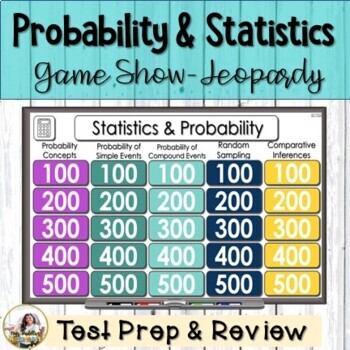7th Grade Review Game | Probability and Statistics Test Prep
- Zip
- Microsoft OneDrive
What educators are saying
Also included in
- This fun, interactive and engaging 7th Grade Review game will have your students asking for more! Expressions and equations, Ratios and proportional relationships, The Number system, Geometry and probability are covered in this bundle. Perfect for end of the unit or end of the year review.Topics iPrice $24.00Original Price $29.88Save $5.88
Description
This fun, interactive and engaging 7th Grade probability and statistics Review game will have your students asking for more! Perfect for end of the unit or end of the year review. It can be use as a Jeopardy review game as a whole group, small group activity, or virtual learning.
This NO PREP game is the PERFECT end of the unit on probability and stiatistics. Your students will have the chance to practice exercises on a fun and engaging way while competing with other classmates.
Don’t worry about the animations, scoreboard, and interactive buttons. They are all set for you. You can play this interactive game as a whole group activity while you project it in the board, in small group centers, or even in virtual learning situations while you share your screen!
Includes:
- Teacher’s Guide & Directions
- 25 Math Review Question Slides (Interactive PowerPoint)
- 25 Math Review Answer Slides (Interactive PowerPoint )
There are several ways this game can be used:
- Whole Group Instruction/Review – Display PowerPoint on Smartboard or classroom screen.
- Remote Learning – Share the PowerPoint on your screen with your students.
- Learning Centers – Set up the PowerPoint on a computer or device for students in the center.
- Test Prep Activity – Since the problems cover the whole unit on expressions, equation and inequalities, this is the PERFECT activity for test prep and review!
Connect with me ⬇
--------------------------------------------------------------------------------------------------------------------------
➯ Be sure to follow my store to be alerted of new products. >> CLICK HERE
➯ Don't forget to leave feedback. You will receive TPT credits (AKA money back) that can be used on future purchases! >> CLICK HERE






